Why Visit Iceland in Winter: Your Complete Guide
November 14, 2024
Why Visit Iceland in Winter: Your Complete Guide
November 14, 2024
Snow-strewn landscapes, spectacular glaciers, and the white peaks of volcanoes—Iceland in winter offers all the wonder you would expect from the land of ice and fire. It’s a fantastic time to visit, when Iceland is at its most magical, thrilling, and welcoming.
In this blog post, you’ll discover the sights, attractions, and unique experiences that make winter in Iceland so special. And you’ll find some of the most important information to know to enjoy your trip.
At Reykjavik Excursions, we offer various tours and activities for winter travel in Iceland. They give you the easiest way to see the country in all of its wintry glory.
When are the winter months in Iceland?
In Iceland, winter is the longest season, incorporating the months of November, December, January, February, and March. This is the time when Iceland is at its coldest and darkest.
Once upon a time, when Iceland used the Old Norse calendar, the country had only two seasons—summer and winter—that each lasted for six months. According to this traditional calendar, April would be a winter month too , as winter would run from the last week of October to the last week of April.
In fact, still today, the first Thursday after 18 April is celebrated as a national holiday in Iceland—to welcome the warmer, longer days of summer. Of course, though, official summertime doesn’t stop the temperature often being below freezing, sometimes even into May.
What is Iceland like in winter?
Being so far north, Iceland in winter is typically cold and dark. It’s also mesmerizingly beautiful—with snow-covered mountains, gorgeous pale wintry light, and the opportunity for ice adventures.
In Reykjavik, temperatures between October and March range between 0.6°C (33.1°F) and 4.9°C (40.8°F). While they can fall a lot lower than that (the city’s record low temperature is -19.7°C, or -3.5°F), usually they don’t often drop too far below zero. You should expect it to be much colder outside of the city though.
That’s why, at this time of year, the glaciers that have formed Iceland’s landscape grow larger. These can be explored by foot or snowmobile, and you can discover the world of caves and caverns that form beneath them too.
Of course, we couldn’t talk about Iceland in winter without mentioning the northern lights. An unbelievable phenomenon for which Iceland is particularly renowned, the aurora borealis shimmer across clear winter skies at night. It’s not something to be missed.
In winter, Iceland’s villages and towns show a different side too. Much of life goes on indoors and every home or bar becomes a cosy, warm, and welcoming place to be. There’s nothing quite like that feeling of coming in from the cold to sit down by the fire with a beer or a mug of cocoa.
Christmas in Iceland
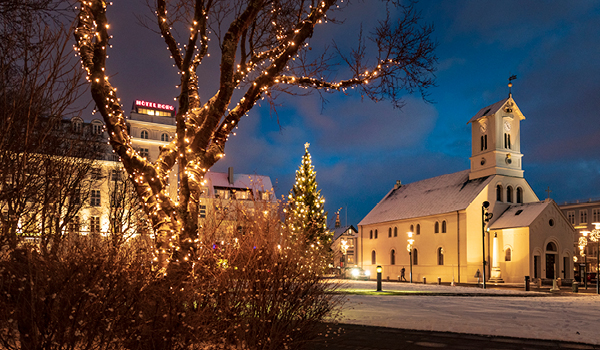
Did you know that there is not one, but thirteen Santa Clauses in Iceland’s Christmas traditions? That every year a book flood takes place and that a sock-stealing Christmas cat stalks the streets of Reykjavik? Browse our selection of things to see and do at Christmas in Iceland for some inspiration.
Is Iceland completely dark in winter?
The far north of Europe has the reputation for being completely dark throughout the winter. But this is actually a bit of a myth.
On the shortest day of the year—the 21 December—Reykjavik has over four hours of daylight, with the sun rising at 11:22 and setting at 15:29. But at the beginning of November, Reykjavik gets eight hours of daylight. And in early March, the day lasts for over 10 hours.
Of course, the further north you go, the shorter the days will become. But there’s still plenty of daylight to enjoy, and plenty to enjoy indoors when it’s dark outside.
Is Iceland snowy in winter?
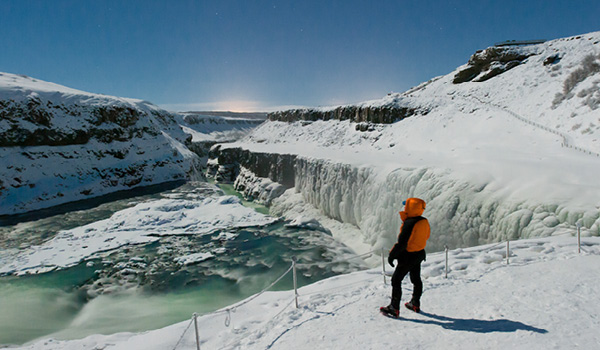
Iceland in winter has very low temperatures—which makes the whole country very snowy. It does have some of Europe’s largest glaciers for a reason!
But how much does it snow in Iceland? In Reykjavik, there are only four months of the year where there is no snowfall at all: June through to September. In any average year, you can expect at least a little bit of snow in every other month of the year.
In winter, from December to March, the Icelandic capital sees between 17 and 23 centimetres (between 6.7 and 9 inches) of snow each month on average, according to the Icelandic Met Office. March is typically the snowiest month, with 23.2 cm (9.1 inches) of snow.
Yet just as temperatures fall as you leave the city, snow is more likely outside of Reykjavik, particularly at height.
Driving in Iceland in winter
Driving in Iceland during the winter is often a worry for visitors. However, the roads are well maintained and Icelanders typically travel around the country by car—even during winter.
But weather conditions in Iceland can be volatile, particularly during the winter. And you may not want to risk the hassle of road closures or the risk of bad weather.
If you do choose to drive, consider some of our advice:
Hire a car prepared for winter conditions. Trusted car-hire operators should make sure that your car is ready for the winter road.
Always plan ahead. Give yourself plenty of time to get to your destination. You don’t want to be caught out when it gets dark.
Check the weather forecast before travelling. If heavy snow or a winter storm is forecast, it’s best not to travel. For the most reliable information, use the Iceland Met Office's website.
Stick to the major roads. Southern Iceland has paved and reliable roads. But in Iceland’s Highlands, or in parts of the north and east, that’s not always the case. We wouldn’t recommend that you drive unpaved roads unless you’re experienced. Always check the road conditions beforre heading out for a drive.
Things to do in Iceland in winter
So, what are the best things to do in winter in Iceland? Explore 10 of our favourite activities to enjoy in Iceland during the colder season.
1. See the northern lights
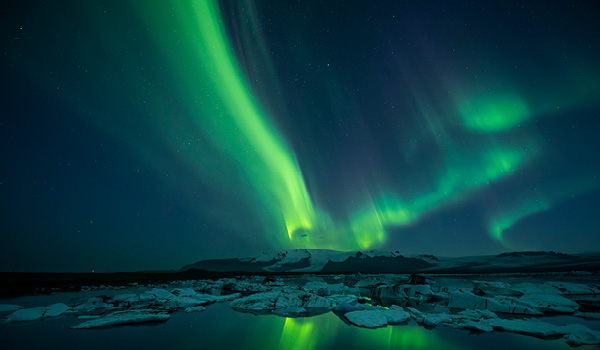
The northern lights are one of the biggest reasons why visitors come to Iceland in winter. That’s because it’s during those long dark nights that this breath-taking display is easiest to see.
For those who don’t know, these dancing waves of light are particles from the sun that crash into the Earth’s atmosphere. They’re most commonly witnessed at the planet’s poles—the north and the south—which makes Iceland a great place to experience the spectacle.
You don’t need to go far from Reykjavik to see them. For example, they can be witnessed from Seltjarnarnes Peninsula, at the northwestern edge of the city. But there are great places across the south of Iceland where you can combine glorious scenery with a glimpse of this extra-terrestrial display.
Explore our range of northern lights tours to find the option that’s best for you.
2. Soak in hot springs and geothermal pools
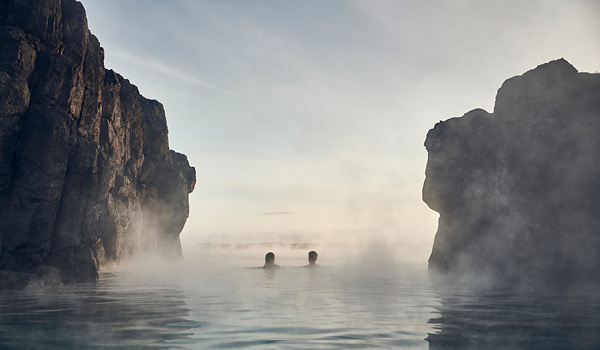
A wholesome, calming experience of Iceland in winter comes from immersing yourself into the warm waters of the country’s geothermal springs and pools. Iceland bears the nickname of the land of ice and fire thanks to the volcanic activity that heats the world below (and sometimes above) the surface of the earth.
Iceland’s geothermal activity makes for an incredible destination for those who love spas and saunas. The Sky Lagoon is a popular option just outside Reykjavik, while the Blue Lagoon is probably Iceland’s most famous spa location.
Yet there are many other hot springs and pools to explore too. Regardless of where you choose, the natural spa experience is a real thrill when you’re surrounded by snow.
3. Travel the famous Golden Circle route
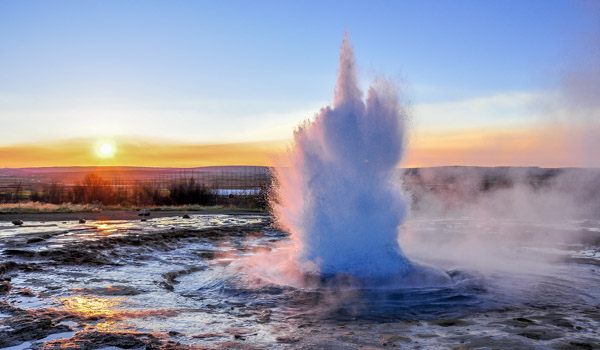
As Iceland’s natural wonders go, there aren’t many more famous than the Golden Circle.
The Golden Circle is the name of the tour itinerary that includes three of south Iceland’s most famous sights: Gullfoss Waterfall, Geysir Geothermal Park, and Þingvellir National Park. Here, marvellous scenery combines with fascinating history, to create experiences that should definitely be included in any trip to Iceland in winter.
In the Geysir Geothermal Park, you’ll see the violent bursts of water that are propelled into the air thanks to geothermal activity. At Gullfoss, witness one of the most awesome torrents of water in Iceland. And in Þingvellir, discover the site of the oldest parliament in the world.
The benefit of visiting in winter? You’ll experience these sublime landscapes without the crowds—but with a splendid dusting of snow instead. Find out the best way to visit with our Golden Circle tours.
4. Visit the South Coast of Iceland in winter
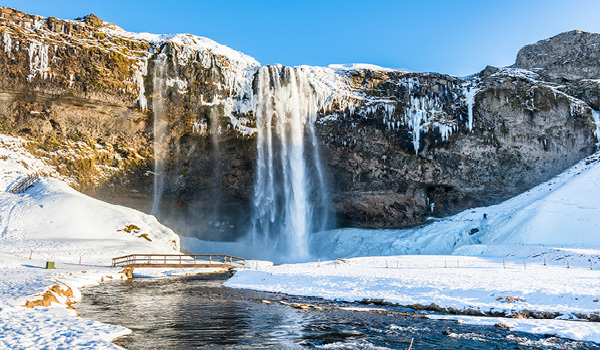
Iceland’s south shore is one of the most fascinating regions in Icleand and there’s plenty of attractions to visit.
Seljalandsfoss and Skógafoss, for example, are two waterfalls in the region that are inspiring in any season. Meanwhile, the national parks of Vatnajökull and Skaftafell host the ancient glaciers that have created Iceland’s sublime landscape, such as Eyjafjallajökull, Sólheimajökull, and Mýrdalsjökull.
One highlight of the south coast is the region around Jökulsárlón, the glacial lagoon. This lagoon has been created by the melting of the Breiðamerkurjökull glacier. As a result, it’s a very special place, where you can see icebergs floating across the serene waters.
The nearby Diamond Beach—with its ice crystals stranded on the black sands—shouldn’t be missed either.
But that’s not all. Explore our full range of south coast tours here.
5. Go glacier hiking and visit ice caves
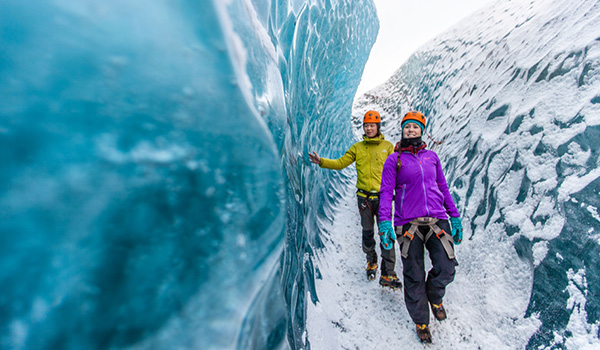
In many ways, its glaciers are what make Iceland so special. And there’s no better moment to witness Europe’s largest sheets of ice than in winter. In fact, with glaciers covering about 11% of the whole island, you’d be missing out if you didn’t pay them a visit.
One of the easiest glaciers to reach is Snæfellsjökull. It’s also one of the most beautiful—and can be seen from Reykjavik on a good day. It sits on the Snæfellsnes Peninsula of western Iceland, where you can see many different landforms—from glaciers to black sand beaches—all in a day.
Alternatively, combine a glacier walk with a visit below the ice. Iceland’s ice caves are a truly unique experience that’s only possible during the winter, when these cold caverns form. The Solheimajokull glacier walk is one of the favourites among visitors to Iceland.
While you’re here, check out all of the glacier and ice cave tours we have available.
6. Take a snowmobile tour
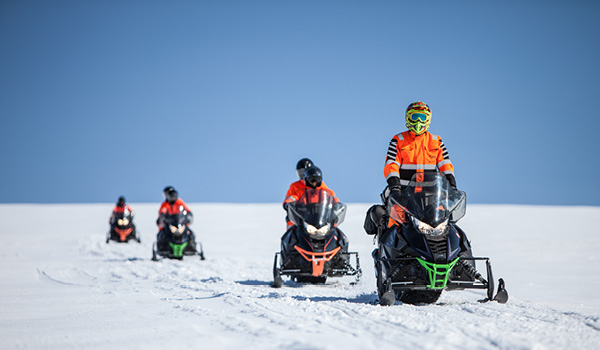
Rather than just walking on the glaciers, why not turn your journey across these massive ice sheets into a dynamic, and even more thrilling, adventure?
Iceland is among the world’s best places to take a glacier tour by snowmobile. This way you can see the magic of these vast expanses of ice, while enjoying the adrenaline rush of higher speeds. In winter, you’ll have to wrap up warm, but it’s one of the most exciting experiences you can have on the ice.
Langjökull and Mýrdalsjökull are two popular glaciers to explore on snowmobile. Explore our snowmobiling tours to book yours.
7. Experience a whale watching tour
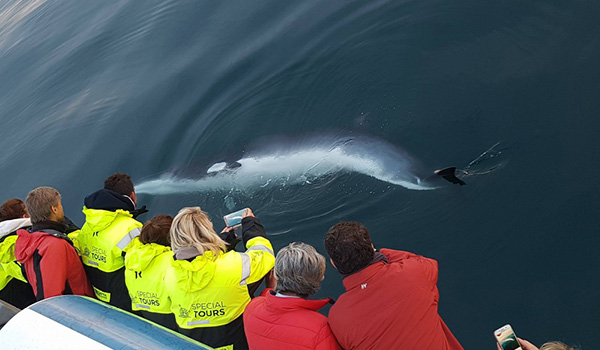
Iceland boasts a surprising range of charming wildlife—from Arctic seals to reindeer, from puffins and white-tailed eagles to the unique Icelandic horses. Yet there’s nothing quite as majestic as the whale. Over 20 species of whale call the seas around Iceland home. These include humpback whales, orca, and even blue whales.
Of course, not all of these amazing creatures are here all year round. But during the winter you can see sperm whales, humpbacks, killer whales, and more species that often venture deep into Iceland’s sea fjords. You’ll see dolphins and seals throughout the year too.
Both Reykjavik and Akureyri in the north are great places to take a whale watching tour. You can explore your whale watching options here.
8. Try winter snorkelling and diving
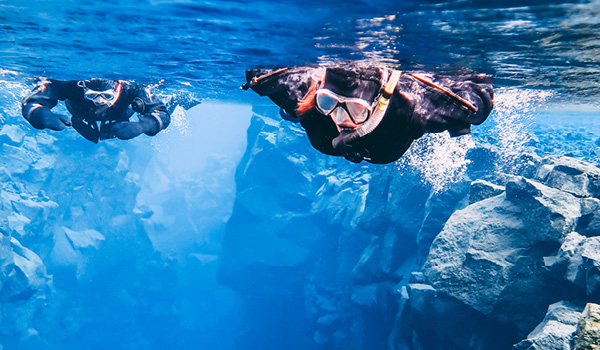
Diving or snorkeling in winter? In Iceland? You bet.
We won’t tell you that it’s warm (although it’s not exactly warm in summer either). But the beauty of submerging yourself into one of Iceland’s lakes is well worth the shock.
One of our favourite places to dive in Iceland is Silfra, in the heart of the Þingvellir National Park. Silfra is a rift in the earth created as two tectonic plates—the Eurasian and the north American—have drifted apart.
You’ll find this deep, mysterious underwater ravine in Þingvallavatn, the largest natural lake in Iceland. What’s particularly cool about the diving experience here? You’ll be swimming in the meltwater from glaciers.
While Silfra is one of the best, it’s not the only diving experience you can have in Iceland. Find out more in our snorkelling and diving tours.
9. Explore the city of Reykjavík
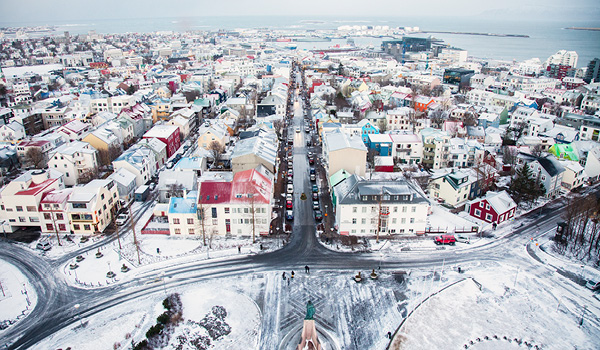
Alongside spectacular scenery, unique activities, and unforgettable experiences, Iceland also offers its fair share of cultural opportunities too. If you’re going to spend some time in any city in Iceland, make it Reykjavik.
Iceland’s capital is an exciting, fascinating, and wonderfully welcoming city at any time of year. But maybe in winter it’s extra-special. Thanks to its unique food and drink culture, impressive architecture, and friendly residents, it makes for an unforgettable experience.
Here’s some of the things that you can get up to:
• Visit the Hallgrímskirkja church, one of the tallest buildings in the country with architecture inspired by the unique geology of Svartifoss waterfall.
• Head up to Perlan. Expect views over the city from Öskjuhlíð hill, along with a magical natural museum.
• Stroll along Laugavegur and Skólavörðustígur. Reykjavik’s two central streets are bustling corridors of boutiques and bars—and are particularly beautiful in winter.
• Take a helicopter tour. Witness Reykjavik and the surrounding area from above.
• Enjoy an authentic food and drink tour. Sample some Icelandic delicacies such as harðfiskur (or stockfish) or hangikjot (smoked lamb). And wash it down with some local beer.
Discover many more things to do in Reykjavik. Or let us show you around on one of our Reykjavik tours.
10. Visit Iceland during Christmas
Visiting Iceland during Christmas and New Year's is a truly magical experience! The holiday season transforms the country into a winter wonderland, with twinkling lights, festive decorations, and a unique blend of Icelandic traditions.
From the 13 mischievous Yule Lads leaving treats (or tricks!) in children's shoes to traditional holiday feasts featuring smoked lamb and baked treats, Icelandic customs bring warmth to the dark winter days. For New Year's, locals gather for bonfires, sing songs, and celebrate with awe-inspiring fireworks displays lighting up the night sky.
Whether you're marveling at the Northern Lights or soaking in a cozy hot spring under a starlit sky, Iceland offers an enchanting holiday getaway like no other.
Christmas and new Year's Eve Tours

Guided holiday tours provide a stress-free way to explore, with expert guides revealing cultural highlights and hidden gems. Perfect for all travelers, these tours offer seamless adventures, blending sightseeing with unique experiences to create unforgettable holiday memories.
What to pack and what to wear in Iceland in winter?
When considering what to wear to visit Iceland in winter, remember one simple thing: it’s going to be pretty cold. That means you’ll need to pack wisely. We recommend bringing a waterproof and windproof jacket, thermal layers, as well as a hat and gloves. If you’re going to visit any of the outdoors sights, sturdy waterproof shoes are a must too.
Generally, it’s smart to dress in layers. These tend to be warmer and they’re more convenient to take off if temperatures change.
Whatever you do, bring a change of clothes too, to change into if you get wet.
Is Iceland worth visiting in winter?
Yes, Iceland is worth visiting in winter. Many of the country’s most famous sights—from the Blue Lagoon to Jökulsárlón, from the Golden Circle to Vatnajökull National Park—are still accessible. And what’s more, you’ll see them in all their fabulous winter glory.
Yet there are particular perks that only visitors to Iceland in winter can enjoy. Consider the northern lights, probably one of the most jaw dropping spectacles on earth. Or the mystery of Iceland’s ice caves. These are simply experiences you wouldn’t be able to enjoy at any other time of year.
Is it best to visit Iceland in winter or summer?
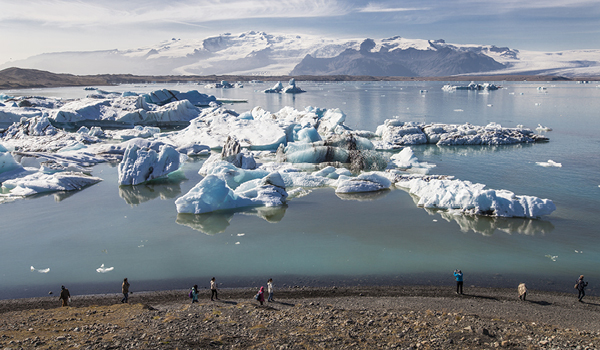
Ultimately, when you want to visit is up to you. There’s no “best” time to visit Iceland. Really, that will depend on what you want to get up to.
If you’re up for experiencing the northern lights, gorgeous snowy landscapes, winter diving, snowmobile rides, and more, the winter is the best time to come. But the summer is full of its own joys too, including the midnight sun, warmer temperatures, and opportunities for outdoor adventure.
Whichever season you prefer to visit, the people of Iceland will make you welcome.
Come and visit Iceland in winter with Reykjavik Excursions
Iceland in winter is a destination that’s icy and serene, and warm and welcoming, in equal measure. With its mighty glaciers, winter wildlife, and the superb display of the northern lights, it promises an experience you’ll never forget.
Whenever you decide to come to Iceland, trust Reykjavik Excursions to make your travel easier. We run tours across Iceland’s south coast throughout the year and we can help you organise your own tailored journey too. We’ll help you travel in comfort, style, and safety no matter the season.
Explore our winter tours and activities in Iceland to start your adventure.
Tours in the spotlight
REYKJAVIK EXCURSIONS BLOG
Get inspired! Information and tips and must see places in Iceland, fun facts, customs and more.
The Silver Circle of West Iceland - Your Guide
You’ve heard of the Golden Circle, but here’s why you should head to Iceland’s western region to explore the msytical Silver Circle tour route.
Read BlogWhy Visit Iceland in Winter: Your Complete Guide
November 14, 2024
Why Visit Iceland in Winter: Your Complete Guide
November 14, 2024
Snow-strewn landscapes, spectacular glaciers, and the white peaks of volcanoes—Iceland in winter offers all the wonder you would expect from the land of ice and fire. It’s a fantastic time to visit, when Iceland is at its most magical, thrilling, and welcoming.
In this blog post, you’ll discover the sights, attractions, and unique experiences that make winter in Iceland so special. And you’ll find some of the most important information to know to enjoy your trip.
At Reykjavik Excursions, we offer various tours and activities for winter travel in Iceland. They give you the easiest way to see the country in all of its wintry glory.
When are the winter months in Iceland?
In Iceland, winter is the longest season, incorporating the months of November, December, January, February, and March. This is the time when Iceland is at its coldest and darkest.
Once upon a time, when Iceland used the Old Norse calendar, the country had only two seasons—summer and winter—that each lasted for six months. According to this traditional calendar, April would be a winter month too , as winter would run from the last week of October to the last week of April.
In fact, still today, the first Thursday after 18 April is celebrated as a national holiday in Iceland—to welcome the warmer, longer days of summer. Of course, though, official summertime doesn’t stop the temperature often being below freezing, sometimes even into May.
What is Iceland like in winter?
Being so far north, Iceland in winter is typically cold and dark. It’s also mesmerizingly beautiful—with snow-covered mountains, gorgeous pale wintry light, and the opportunity for ice adventures.
In Reykjavik, temperatures between October and March range between 0.6°C (33.1°F) and 4.9°C (40.8°F). While they can fall a lot lower than that (the city’s record low temperature is -19.7°C, or -3.5°F), usually they don’t often drop too far below zero. You should expect it to be much colder outside of the city though.
That’s why, at this time of year, the glaciers that have formed Iceland’s landscape grow larger. These can be explored by foot or snowmobile, and you can discover the world of caves and caverns that form beneath them too.
Of course, we couldn’t talk about Iceland in winter without mentioning the northern lights. An unbelievable phenomenon for which Iceland is particularly renowned, the aurora borealis shimmer across clear winter skies at night. It’s not something to be missed.
In winter, Iceland’s villages and towns show a different side too. Much of life goes on indoors and every home or bar becomes a cosy, warm, and welcoming place to be. There’s nothing quite like that feeling of coming in from the cold to sit down by the fire with a beer or a mug of cocoa.
Christmas in Iceland

Did you know that there is not one, but thirteen Santa Clauses in Iceland’s Christmas traditions? That every year a book flood takes place and that a sock-stealing Christmas cat stalks the streets of Reykjavik? Browse our selection of things to see and do at Christmas in Iceland for some inspiration.
Is Iceland completely dark in winter?
The far north of Europe has the reputation for being completely dark throughout the winter. But this is actually a bit of a myth.
On the shortest day of the year—the 21 December—Reykjavik has over four hours of daylight, with the sun rising at 11:22 and setting at 15:29. But at the beginning of November, Reykjavik gets eight hours of daylight. And in early March, the day lasts for over 10 hours.
Of course, the further north you go, the shorter the days will become. But there’s still plenty of daylight to enjoy, and plenty to enjoy indoors when it’s dark outside.
Is Iceland snowy in winter?

Iceland in winter has very low temperatures—which makes the whole country very snowy. It does have some of Europe’s largest glaciers for a reason!
But how much does it snow in Iceland? In Reykjavik, there are only four months of the year where there is no snowfall at all: June through to September. In any average year, you can expect at least a little bit of snow in every other month of the year.
In winter, from December to March, the Icelandic capital sees between 17 and 23 centimetres (between 6.7 and 9 inches) of snow each month on average, according to the Icelandic Met Office. March is typically the snowiest month, with 23.2 cm (9.1 inches) of snow.
Yet just as temperatures fall as you leave the city, snow is more likely outside of Reykjavik, particularly at height.
Driving in Iceland in winter
Driving in Iceland during the winter is often a worry for visitors. However, the roads are well maintained and Icelanders typically travel around the country by car—even during winter.
But weather conditions in Iceland can be volatile, particularly during the winter. And you may not want to risk the hassle of road closures or the risk of bad weather.
If you do choose to drive, consider some of our advice:
Hire a car prepared for winter conditions. Trusted car-hire operators should make sure that your car is ready for the winter road.
Always plan ahead. Give yourself plenty of time to get to your destination. You don’t want to be caught out when it gets dark.
Check the weather forecast before travelling. If heavy snow or a winter storm is forecast, it’s best not to travel. For the most reliable information, use the Iceland Met Office's website.
Stick to the major roads. Southern Iceland has paved and reliable roads. But in Iceland’s Highlands, or in parts of the north and east, that’s not always the case. We wouldn’t recommend that you drive unpaved roads unless you’re experienced. Always check the road conditions beforre heading out for a drive.
Things to do in Iceland in winter
So, what are the best things to do in winter in Iceland? Explore 10 of our favourite activities to enjoy in Iceland during the colder season.
1. See the northern lights

The northern lights are one of the biggest reasons why visitors come to Iceland in winter. That’s because it’s during those long dark nights that this breath-taking display is easiest to see.
For those who don’t know, these dancing waves of light are particles from the sun that crash into the Earth’s atmosphere. They’re most commonly witnessed at the planet’s poles—the north and the south—which makes Iceland a great place to experience the spectacle.
You don’t need to go far from Reykjavik to see them. For example, they can be witnessed from Seltjarnarnes Peninsula, at the northwestern edge of the city. But there are great places across the south of Iceland where you can combine glorious scenery with a glimpse of this extra-terrestrial display.
Explore our range of northern lights tours to find the option that’s best for you.
2. Soak in hot springs and geothermal pools

A wholesome, calming experience of Iceland in winter comes from immersing yourself into the warm waters of the country’s geothermal springs and pools. Iceland bears the nickname of the land of ice and fire thanks to the volcanic activity that heats the world below (and sometimes above) the surface of the earth.
Iceland’s geothermal activity makes for an incredible destination for those who love spas and saunas. The Sky Lagoon is a popular option just outside Reykjavik, while the Blue Lagoon is probably Iceland’s most famous spa location.
Yet there are many other hot springs and pools to explore too. Regardless of where you choose, the natural spa experience is a real thrill when you’re surrounded by snow.
3. Travel the famous Golden Circle route

As Iceland’s natural wonders go, there aren’t many more famous than the Golden Circle.
The Golden Circle is the name of the tour itinerary that includes three of south Iceland’s most famous sights: Gullfoss Waterfall, Geysir Geothermal Park, and Þingvellir National Park. Here, marvellous scenery combines with fascinating history, to create experiences that should definitely be included in any trip to Iceland in winter.
In the Geysir Geothermal Park, you’ll see the violent bursts of water that are propelled into the air thanks to geothermal activity. At Gullfoss, witness one of the most awesome torrents of water in Iceland. And in Þingvellir, discover the site of the oldest parliament in the world.
The benefit of visiting in winter? You’ll experience these sublime landscapes without the crowds—but with a splendid dusting of snow instead. Find out the best way to visit with our Golden Circle tours.
4. Visit the South Coast of Iceland in winter

Iceland’s south shore is one of the most fascinating regions in Icleand and there’s plenty of attractions to visit.
Seljalandsfoss and Skógafoss, for example, are two waterfalls in the region that are inspiring in any season. Meanwhile, the national parks of Vatnajökull and Skaftafell host the ancient glaciers that have created Iceland’s sublime landscape, such as Eyjafjallajökull, Sólheimajökull, and Mýrdalsjökull.
One highlight of the south coast is the region around Jökulsárlón, the glacial lagoon. This lagoon has been created by the melting of the Breiðamerkurjökull glacier. As a result, it’s a very special place, where you can see icebergs floating across the serene waters.
The nearby Diamond Beach—with its ice crystals stranded on the black sands—shouldn’t be missed either.
But that’s not all. Explore our full range of south coast tours here.
5. Go glacier hiking and visit ice caves

In many ways, its glaciers are what make Iceland so special. And there’s no better moment to witness Europe’s largest sheets of ice than in winter. In fact, with glaciers covering about 11% of the whole island, you’d be missing out if you didn’t pay them a visit.
One of the easiest glaciers to reach is Snæfellsjökull. It’s also one of the most beautiful—and can be seen from Reykjavik on a good day. It sits on the Snæfellsnes Peninsula of western Iceland, where you can see many different landforms—from glaciers to black sand beaches—all in a day.
Alternatively, combine a glacier walk with a visit below the ice. Iceland’s ice caves are a truly unique experience that’s only possible during the winter, when these cold caverns form. The Solheimajokull glacier walk is one of the favourites among visitors to Iceland.
While you’re here, check out all of the glacier and ice cave tours we have available.
6. Take a snowmobile tour

Rather than just walking on the glaciers, why not turn your journey across these massive ice sheets into a dynamic, and even more thrilling, adventure?
Iceland is among the world’s best places to take a glacier tour by snowmobile. This way you can see the magic of these vast expanses of ice, while enjoying the adrenaline rush of higher speeds. In winter, you’ll have to wrap up warm, but it’s one of the most exciting experiences you can have on the ice.
Langjökull and Mýrdalsjökull are two popular glaciers to explore on snowmobile. Explore our snowmobiling tours to book yours.
7. Experience a whale watching tour

Iceland boasts a surprising range of charming wildlife—from Arctic seals to reindeer, from puffins and white-tailed eagles to the unique Icelandic horses. Yet there’s nothing quite as majestic as the whale. Over 20 species of whale call the seas around Iceland home. These include humpback whales, orca, and even blue whales.
Of course, not all of these amazing creatures are here all year round. But during the winter you can see sperm whales, humpbacks, killer whales, and more species that often venture deep into Iceland’s sea fjords. You’ll see dolphins and seals throughout the year too.
Both Reykjavik and Akureyri in the north are great places to take a whale watching tour. You can explore your whale watching options here.
8. Try winter snorkelling and diving

Diving or snorkeling in winter? In Iceland? You bet.
We won’t tell you that it’s warm (although it’s not exactly warm in summer either). But the beauty of submerging yourself into one of Iceland’s lakes is well worth the shock.
One of our favourite places to dive in Iceland is Silfra, in the heart of the Þingvellir National Park. Silfra is a rift in the earth created as two tectonic plates—the Eurasian and the north American—have drifted apart.
You’ll find this deep, mysterious underwater ravine in Þingvallavatn, the largest natural lake in Iceland. What’s particularly cool about the diving experience here? You’ll be swimming in the meltwater from glaciers.
While Silfra is one of the best, it’s not the only diving experience you can have in Iceland. Find out more in our snorkelling and diving tours.
9. Explore the city of Reykjavík

Alongside spectacular scenery, unique activities, and unforgettable experiences, Iceland also offers its fair share of cultural opportunities too. If you’re going to spend some time in any city in Iceland, make it Reykjavik.
Iceland’s capital is an exciting, fascinating, and wonderfully welcoming city at any time of year. But maybe in winter it’s extra-special. Thanks to its unique food and drink culture, impressive architecture, and friendly residents, it makes for an unforgettable experience.
Here’s some of the things that you can get up to:
• Visit the Hallgrímskirkja church, one of the tallest buildings in the country with architecture inspired by the unique geology of Svartifoss waterfall.
• Head up to Perlan. Expect views over the city from Öskjuhlíð hill, along with a magical natural museum.
• Stroll along Laugavegur and Skólavörðustígur. Reykjavik’s two central streets are bustling corridors of boutiques and bars—and are particularly beautiful in winter.
• Take a helicopter tour. Witness Reykjavik and the surrounding area from above.
• Enjoy an authentic food and drink tour. Sample some Icelandic delicacies such as harðfiskur (or stockfish) or hangikjot (smoked lamb). And wash it down with some local beer.
Discover many more things to do in Reykjavik. Or let us show you around on one of our Reykjavik tours.
10. Visit Iceland during Christmas
Visiting Iceland during Christmas and New Year's is a truly magical experience! The holiday season transforms the country into a winter wonderland, with twinkling lights, festive decorations, and a unique blend of Icelandic traditions.
From the 13 mischievous Yule Lads leaving treats (or tricks!) in children's shoes to traditional holiday feasts featuring smoked lamb and baked treats, Icelandic customs bring warmth to the dark winter days. For New Year's, locals gather for bonfires, sing songs, and celebrate with awe-inspiring fireworks displays lighting up the night sky.
Whether you're marveling at the Northern Lights or soaking in a cozy hot spring under a starlit sky, Iceland offers an enchanting holiday getaway like no other.
Christmas and new Year's Eve Tours

Guided holiday tours provide a stress-free way to explore, with expert guides revealing cultural highlights and hidden gems. Perfect for all travelers, these tours offer seamless adventures, blending sightseeing with unique experiences to create unforgettable holiday memories.
What to pack and what to wear in Iceland in winter?
When considering what to wear to visit Iceland in winter, remember one simple thing: it’s going to be pretty cold. That means you’ll need to pack wisely. We recommend bringing a waterproof and windproof jacket, thermal layers, as well as a hat and gloves. If you’re going to visit any of the outdoors sights, sturdy waterproof shoes are a must too.
Generally, it’s smart to dress in layers. These tend to be warmer and they’re more convenient to take off if temperatures change.
Whatever you do, bring a change of clothes too, to change into if you get wet.
Is Iceland worth visiting in winter?
Yes, Iceland is worth visiting in winter. Many of the country’s most famous sights—from the Blue Lagoon to Jökulsárlón, from the Golden Circle to Vatnajökull National Park—are still accessible. And what’s more, you’ll see them in all their fabulous winter glory.
Yet there are particular perks that only visitors to Iceland in winter can enjoy. Consider the northern lights, probably one of the most jaw dropping spectacles on earth. Or the mystery of Iceland’s ice caves. These are simply experiences you wouldn’t be able to enjoy at any other time of year.
Is it best to visit Iceland in winter or summer?

Ultimately, when you want to visit is up to you. There’s no “best” time to visit Iceland. Really, that will depend on what you want to get up to.
If you’re up for experiencing the northern lights, gorgeous snowy landscapes, winter diving, snowmobile rides, and more, the winter is the best time to come. But the summer is full of its own joys too, including the midnight sun, warmer temperatures, and opportunities for outdoor adventure.
Whichever season you prefer to visit, the people of Iceland will make you welcome.
Come and visit Iceland in winter with Reykjavik Excursions
Iceland in winter is a destination that’s icy and serene, and warm and welcoming, in equal measure. With its mighty glaciers, winter wildlife, and the superb display of the northern lights, it promises an experience you’ll never forget.
Whenever you decide to come to Iceland, trust Reykjavik Excursions to make your travel easier. We run tours across Iceland’s south coast throughout the year and we can help you organise your own tailored journey too. We’ll help you travel in comfort, style, and safety no matter the season.
Explore our winter tours and activities in Iceland to start your adventure.
Tours in the spotlight
REYKJAVIK EXCURSIONS BLOG
Get inspired! Information and tips and must see places in Iceland, fun facts, customs and more.
The Silver Circle of West Iceland - Your Guide
You’ve heard of the Golden Circle, but here’s why you should head to Iceland’s western region to explore the msytical Silver Circle tour route.
Read Blog